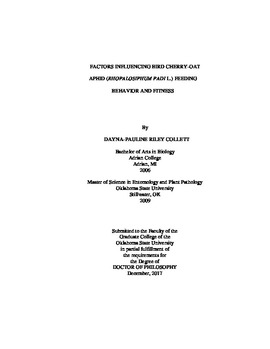| dc.contributor.advisor | Giles, Kristopher L. | |
| dc.contributor.author | Collett, Dayna-Pauline R. | |
| dc.date.accessioned | 2018-06-18T16:02:31Z | |
| dc.date.available | 2018-06-18T16:02:31Z | |
| dc.date.issued | 2017-12 | |
| dc.identifier.uri | https://hdl.handle.net/11244/300086 | |
| dc.description.abstract | The first objective of this dissertation was to determine if increasingly complex host plant habitats resulted in the most fit Rhopalosiphum padi. I hypothesized that the addition of suitable host plant species to R. padi rearing cages, in an effort to mimic heterogeneous agroecosystems, would increase aphid fitness. By comparing the weight and number of R. padi produced between treatments, the primary hypothesis that the availability/utilization of additional suitable host plants to aphid rearing cages would increase fitness was rejected. Conversely, the data revealed a potentially antagonistic relationship between host plants when grown in close proximity and resulted in a negative effect on aphid fitness. Factors including natal experience effects, plant-plant interactions, lack of host plant conditioning, and/or host plant composition effects may have impacted R. padi fitness in this study. The second objective of this study was to quantify host-plant feeding behaviors for R. padi reared under different conditions. Results from the first objective indicated that experimental R. padi reared uncrowded on wheat, under ideal environmental conditions, were larger. In comparison, R. padi from the source colony were substantially smaller and would be predicted to be less fit, and thus cause less plant injury. I hypothesized that differences in rearing conditions had the potential to influence R. padi feeding behavior. Behaviors were quantified using salivary sheath staining and electropenetrography techniques. Results supported the hypothesis that differences in rearing conditions of R. padi impact feeding behaviors, as significant differences were revealed for typical feeding behaviors between the two aphid rearing conditions. Results indicated that the most "fit" experimental colony aphids (i.e. larger and with higher fitness) may not be the best for plant injury evaluations, but because of their propensity to initiate more feeding attempts, may be highly beneficial in barley yellow dwarf virus (BYDV) transmission study evaluations. Alternatively, the "stressed" source colony, reared under crowded, less optimal environmental conditions, appear more likely to feed for extended periods of time and induce plant injury. These differences should be considered when evaluating the impact of aphid feeding on host plants during screening of resistant plant sources. | |
| dc.format | application/pdf | |
| dc.language | en_US | |
| dc.rights | Copyright is held by the author who has granted the Oklahoma State University Library the non-exclusive right to share this material in its institutional repository. Contact Digital Library Services at lib-dls@okstate.edu or 405-744-9161 for the permission policy on the use, reproduction or distribution of this material. | |
| dc.title | Factors influencing bird cherry-oat aphid (Rhopalosiphum padi L.) feeding behavior and fitness | |
| dc.contributor.committeeMember | Wayadande, Astri Cassandra | |
| dc.contributor.committeeMember | Hunger, Robert M. | |
| dc.contributor.committeeMember | Carver, Brett Frederick | |
| dc.contributor.committeeMember | Payton, Mark E. | |
| osu.filename | Collett_okstate_0664D_15499.pdf | |
| osu.accesstype | Open Access | |
| dc.type.genre | Dissertation | |
| dc.type.material | Text | |
| thesis.degree.discipline | Entomology | |
| thesis.degree.grantor | Oklahoma State University | |
